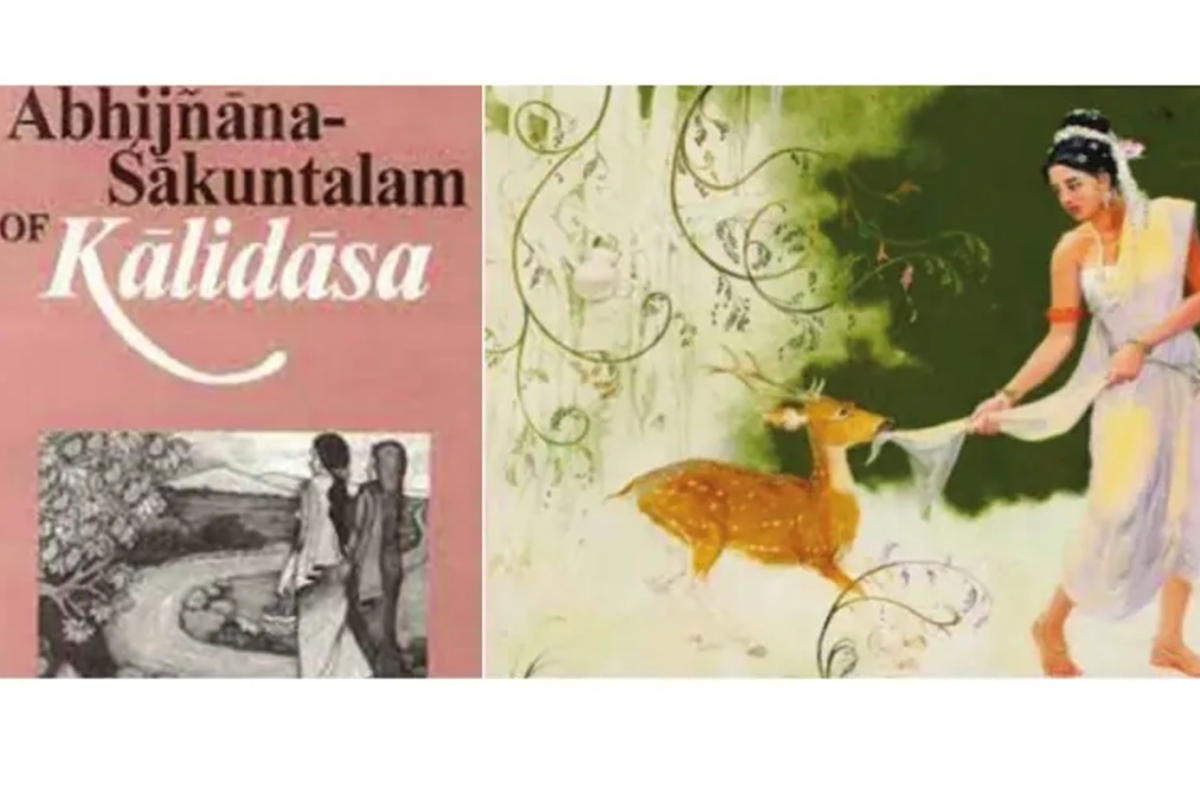Many scholars speculate that it is highly improbable that the greatest poet of ancient India had only seven creative works to his credit; he must have had many more creations which have been lost forever for lack of circulation and preservation of the perishable manuscripts.
If the story of his alleged migration from north (or central!) India to the distant island of Sri Lanka to join the court of Kumaradasa (around 517 CE), where he was killed for treachery, is to be believed, that will explain probable loss of many of his works which he carried with him and others produced during his stay in Sri Lanka. As mentioned earlier, Kalidasa would have been forgotten altogether had his works not been unearthed and translated by the western Indologists and if the British scholars didn’t come to India.
Advertisement
While several poets like Banabhatta (7th century) and later Jayadeva praised Kalidasa, Kalidasa never became a part of popular culture till the advent of Sir William Jones in India and the establishment of the Asiatic Society in Kolkata. A multi-faceted genius ~ mathematician, philologist (proficient in eight languages), Orientalist and jurist ~ William Jones came to Kolkata in 1783 as a judge of the Supreme Court at Fort William, Kolkata. Entranced by Indian culture, this amazing judge started studying the Vedas, Indian astronomy and Indian laws and soon became a proficient Sanskritist.
During his short working life (he died at the age of 47 in Kolkata), he produced a flood of works on India and launched modern study of almost all aspects of social sciences and culture of India. One of his remarkable achievements had been publication of the English translation of Sakuntala from the original Sanskrit in 1791 and of Ritusamhara in original Sanskrit text in 1792.
His pioneering work set in motion Europe’s interest in Kalidasa’s work and in Sanskrit literature in general. Of the 155 extant Sanskrit plays by 24 authors, at least 46 plays have been translated into English. But the most translated Sanskrit play in different languages has been Kalidasa’s Abhijnanasakuntalam that made him a household name. In his “Bibliography of Sanskrit Drama,” Montgomery Schuyler Jr. serialised the dramatic works of Kalidasa including translations of his plays.
Sir William Jones was the first person to call Kalidasa Shakespeare of India and since then, Kalidas is referred to as such in popular culture. According to author and scholar M R Kale, “the very comparison of Kalidasa to Shakespeare is the highest form (of ) eulogy that could be bestowed upon him.” Sir Monier Williams, an Indologist has said, “No composition of Kalidasa displays more the richness of his poetical genius, the exuberance of his imagination, the warmth and play of his fancy, his profound knowledge of the human heart, his delicate appreciation of its most refined and tender emotions, his familiarity with workings and counter-workings of its conflicting feelings ~ in short more entitles him to rank as the Shakespeare of India.’
According to Wilhelm von Humboldt, German linguist, diplomat and philosopher and founder of the Humboldt University of Berlin, “Kalidasa, the celebrated author of Sakuntala, is a masterly describer of the influence which Nature exercises upon the minds of lovers. Tenderness in the expression of feelings and richness of creative fancy has assigned to him his lofty place among the poets of all nations.” Abhijnanasakuntalam (Sakuntala) had been of one of the first works of Indian literature to reach the literary circles of Europe through an English translation and then from English into German.
The German edition of Sakuntala enthralled the eminent German poets of the time ~ Goethe, Herder, Schiller and others who received it with wonder and fascination. Wolfgang von Goethe was so mesmerised by the beauty of Sakuntala that he used it as a prologue for his famous play Faust in the following poem: Wouldst thou the young year’s blossoms and the fruits of its decline, And all by which the soul is charmed, enraptured, feasted, fed, Wouldst thou the earth and heaven itself in one sole name combine? I name thee, O Sakuntala! And all at once is said. (Translation from German by E B Eastwick) On another occasion, Goethe praised Kalidasa in the following words, “Here the poet seems to be in the height of his talent in the representation of the natural order, of the finest mode of life, of the purest moral endeavour, of the most worthy sovereign, and of the most sober divine meditation, still he remains in such a manner the lord and master of his creation.”
(Goethe, quoted in Winternitz) Although called the Indian Shakespeare and regarded as one of the greatest poets of the world and the greatest in ancient India, Kalidasa was not taught in the Indian schools and colleges in the British Raj during the 19th century because literary works like Sakuntala were deemed, in the words of Charles Trevelyan, to be “marked with the greatest immorality and impurity.”
The colonial administration thought that the Indian students were insufficiently morally and intellectually advanced to read the Indian texts that were taught and appreciated in Great Britain. Unfortunately, perhaps the same colonial mindset continues ~ while Shakespeare’s works are taught extensively in the Indian schools, colleges and universities, works of Kalidasa hardly find a place in the curriculum. Study of Sanskrit (with a capsule containing pieces of great works) had been a compulsory subject in the matriculation course for about one hundred years till the 1950s but the national government of independent India abolished it altogether as a compulsory subject on the plea of promoting secularism and multiculturalism.
The new India seems to have thrown Sanskrit, the mother of the Indo-European languages and the most perfect language producing noblest forms of literature and philosophy into the dustbin of history as a ‘dead language’. In sharp contrast, Sanskrit has become very much a part of intellectual life in Germany where it is taught in schools, colleges and in more than fourteen universities. Generations of German poets, philosophers and intellectuals have been deeply influenced by Sanskrit mythologies, literature and philosophy till today.From the beginning, the Germans had shown great interest in Sanskrit; the first notable scholar had been Heinrich Roth (1620-1668) followed by a galaxy of German poets and scholars.
Friedrich von Schlegel (1772-1829), German poet, critic, scholar, philosopher and Indologist published an epochmaking book On the Language and Wisdom of India (1808) in which he argued that ‘people originating in India were the founders of the first European civilisations.’ He also said, “India is superior in everything ~ intellectually, religiously,… even Greek heritage seems (to) pale in comparison.” Gottfried von Herder (1744- 1803), a theologist and philosopher said, “Mankind’s origins can be traced to India where the human mind got the first shapes of wisdom and virtue.” Then there was the inimitable German genius, Max Muller (1823- 1900), Oxford’s first Professor of Comparative Philology (after he was wrongfully denied the chair for Sanskrit), a great master of Sanskrit,whose remarkable achievements had been the publication of Rig-Veda (6 volumes) in original Sanskrit and a 51-volume series of translations The Sacred Books of the East.
In his early days, he also translated into German some of the Upanishads and the Hitopadesa. Max Muller’s burning passion for Sanskrit language and literature made him one of the greatest scholars of Sanskrit. In his famous lecture “What can India teach us” at Cambridge University in 1883, he did not hesitate to champion the cause of Sanskrit literature and India although he was often dubbed as anti-Hindu. He said, “If I were to look over the whole world to find out the country most richly endowed with all the wealth, power and beauty that nature can bestow ~ in some parts a paradise on earth ~ I should point to India. If I were to ask under what sky the human mind has most full developed some of the choicest gifts … I should point to India. And if I were to ask myself from what we, here in Europe, may draw that corrective which is most wanted in order to make our inner life more perfect, more comprehensive, more universal and in fact more truly human, a life, not for this life only, but a transfigured and eternal life ~ again I should point to India.” Max Muller had been severely criticised by many of his contemporaries for his views about India, but coming as it is from one of the greatest Sanskrit pundits, he cannot be ignored.
The rulers of new India and a vast number of historians, intellectuals and academicians, leftists, secularists and political activists tend to deny the rightful place of Sanskrit and refuse to accept the greatness and relevance of India’s heritage, literature and culture thus minimizing their importance. As Francois Gautier, French author and journalist, pointing at anti-culture developments in modern India, has said in his book Wonder That is India (1994), a country which forgets its ancient heritage and culture must be an unfortunate nation. Should we term India an unfortunate nation? Let the new generation reflect about it and decide.
(The writer is a former Dy. Comptroller &Auditor General of India and a former Ombudsman of Reserve Bank of India. He is also a writer of several books and can be reached at brahmas@gmail.com)











